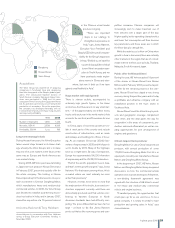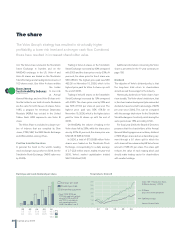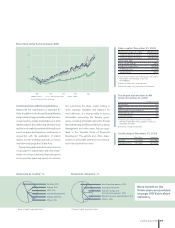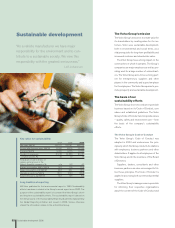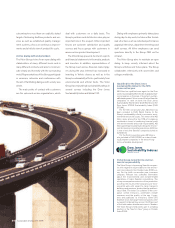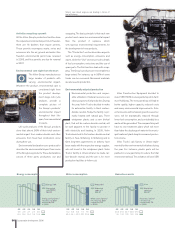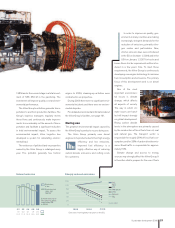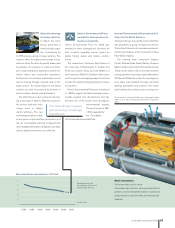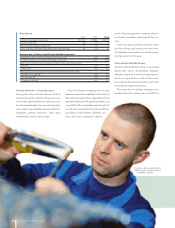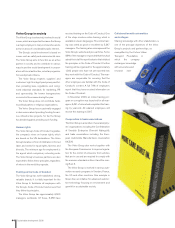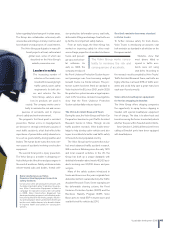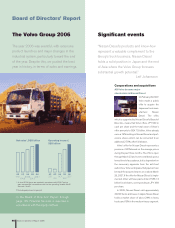Volvo 2006 Annual Report Download - page 42
Download and view the complete annual report
Please find page 42 of the 2006 Volvo annual report below. You can navigate through the pages in the report by either clicking on the pages listed below, or by using the keyword search tool below to find specific information within the annual report.
other than crude oil. These efforts focus largely
on the development of new drivelines, energy
efficiency and alternative fuels.
Tomorrow’s transport solutions
The Volvo Group is well prepared to meet future
environmental and energy challenges. Signifi-
cant resources are invested in ongoing efforts
to improve the fuel efficiency of diesel engines
and thereby cut fuel consumption. In addition to
benefiting the envi-
ronment, this also
improves custom-
ers’ profits since
fuel represents a
sizeable share of their costs.
Meanwhile, the Volvo Group must continue
its work to adapt diesel engines for various
alternative fuels and develop new drivelines, for
instance through hybrid technology for heavy
vehicles.
Increasingly efficient engines
Since 1980, the fuel consumption
of Volvo’s trucks has dropped by
30% at the same time as the engines have
become cleaner. Over the past 30 years, diesel
engines have seen a hundredfold reduction of
regulated emissions.
Further important strides were taken in
2006. The Volvo Group presented a completely
new engine family to meet the stricter environ-
mental requirements introduced in North
America on January 1, 2007. The Volvo Group
was among the first truck manufacturers to
have its engines approved according to US’07
by the US Environmental Protection Agency.
The US has a highly ambitious plan for
reducing emissions from heavy traffic. Starting
from 2007, the proportion of nitrogen oxide
and particulates will be reduced by 50% and
90% respectively in new engines. Emission
requirements in the US will become even
stricter in 2010.
In Europe, the Group’s heavy engines meet
the stricter Euro 4 emission requirements that
took effect on October 1, 2006. Meanwhile,
Volvo has developed an engine that already
meets the new requirements to take effect in
2009. Since April 2006, a refuse truck has
been in use with a D13 engine that meets Euro
5 requirements – three years before these
requirements come into force. This is the
Group’s first delivery of a Euro 5 product.
Alternative fuels
A diesel engine is a
highly effective energy
converter and can run
on various fuels such as synthetic diesel and
DME (dimethyl ether). Diesel engines provide
the basis for various types of hybrids with elec-
tric motors, batteries and fuel cells. The Volvo
Group is a leader of this development.
In 2006, the Swedish National Energy
Administration awarded AB Volvo a grant of
SEK 62 M for the development of third-genera-
tion DME engines for heavy vehicles between
2006 and 2010. The project will generate
automotive technology for a major field test of
DME-powered trucks, which is scheduled for
2009 and 2010. The Volvo Group is also invest-
ing heavily in the project.
Other interesting renewable fuels are biodie-
sel (FAME, Fatty Acid Methyl Esters) and bio-
gas. FAME works splendidly in low-blends with
conventional diesel fuel. Minor adjustments of
the engines will make them run on 100 %
biodiesel. Biogas emits minimal amounts of
particulates, nitrogen oxides, carbon-dioxide
and the level of noise in the vehicle is also lower.
This makes biogas particularly suitable for
vehicles in city traffic.
All heavy trucks and buses registered in EU coun-
tries from October 1, 2006, onwards must meet
Euro 4 requirements. An engine that meets
Euro 3 requirements differs significantly from a
Euro 4-compliant engine in terms of its exhaust
gas emissions. Emissions of nitrogen oxide
(NOx) must be cut from 5 to 3.5 g/kWh, a
decrease of 30%. Particulate emissions (PM)
must drop from 0.1 to 0.02 g/kWh, a reduction
of 80%. Euro 5, which takes effect on October1,
2009, will reduce NOx emission levels by half
compared to Euro 4.
US 10, 2010
US 07, 2007
0.16
0.14
0.12
0.10
0.08
0.06
0.04
0.02
0.00
Particles g/KWh
NOx g/KWh
012345678
Euro 2, 1996
Euro 3, 2002
Euro 4, 2006
Euro 5, 2009
US 02, 2002
Emission standards for
trucks and buses
Nitrogen oxide and particulate emissions have
fallen by about 60% since 1996. When Tier 3
was introduced, Volvo Construction Equipment
launched products equipped with the new V-
ACT technology (Volvo Advanced Combustion
Technology), which minimizes emissions by
adjusting the combustion process in the engine.
Nitrogen oxide and particulate emissions will
decline by a further 90% by 2014 compared
with today’s Tier 3 level.
Emission standards for
construction equipment
Engine Power: 130-225 KW
Particles g/KWh
Tier 4B, 2014
Tier 4A, 2011
0.6
0.5
0.4
0.3
0.2
0.1
0
NOx, g/kWh
80 1234567 9
Tier 1, 1996
Tier 2, 2002Tier 3, 2006
Both Europe and North America
are introducing increasingly strict
emissions laws.
38 Sustainable development 2006



